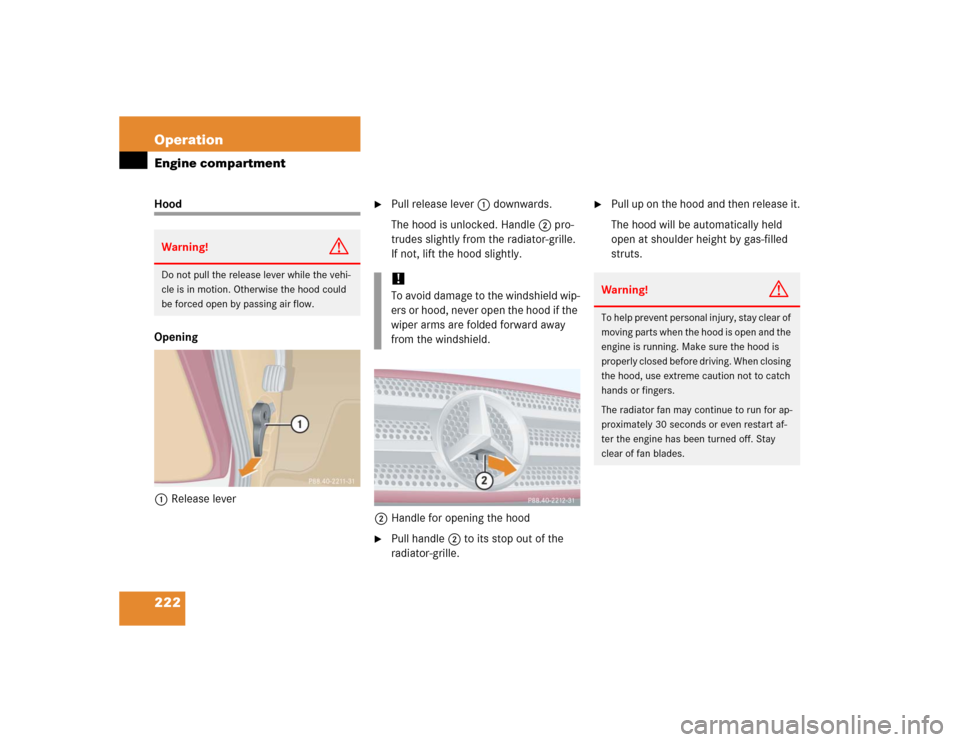Page 209 of 356

207 Operation
Driving instructions
Traction in steep terrain�
Be easy on the accelerator and watch
for continuous wheel traction when
driving in steep terrain.
The 4-ETS helps greatly when starting
out on a steep incline when the front
wheels have then the tendency to slip
due to the weight shifting away the
front axle.
The 4-ETS recognizes the situation and
limits the torque for the front wheels by
braking them. Simultaneously the
torque for the rear wheels is increased.Driving across a hilltop
�
Decelerate just ahead of a hilltop (do
not select gear rangeN), to prevent the
vehicle from speeding up too much af-
ter climbing a hill.
Use the momentum of the vehicle to
drive across the hilltop.
Driving in this manner prevents the ve-
hicle from jumping across the hilltop
and thus loosing its forward momen-
tum.Driving downhill
�
Select gear range1 on the automatic
transmission (
�page 122).
�
Drive downhill observing the same
rules as driving uphill (
�page 206).
�
The special LOW RANGE – ABS setting
allows for precise and brief (cyclical)
blocking of the front wheels, permitting
them to dig into loose ground.
Remember that the front wheels when
stopped, slide across a surface, thus
loose their ability to steer the vehicle.
Page 216 of 356

214 OperationDriving instructionsTowing a trailer
There are many different laws, including
speed limit restrictions, having to do with
trailer towing. Make sure your rig will be le-
gal, not only for where you reside, but also
for where you will be driving. A good
source for this information can be the po-
lice or local authorities.
Note the following points, when driving
with the trailer:�
In order to gain skill and an under-
standing of the vehicle’s behavior, you
should practice turning, stopping and
backing up in an area which is free from
traffic.
�
Before you start driving check the�
trailer hitch
�
break-away switch
�
safety chains
�
electrical connections
�
lighting and tiresAdjust the mirrors to permit unobstructed
view beyond rear of trailer.
�
If the trailer has electric brakes, start
your vehicle and trailer moving slowly,
and then apply only the trailer brake
controller by hand to make sure the
brakes are working properly.
�
Always secure items in the trailer to
prevent load shifts while driving.
�
When towing a trailer, check occasion-
ally to make sure the load is secure,
and that lighting and trailer brakes (if
so equipped) are functioning properly.
�
Take into consideration that when tow-
ing a trailer, the handling characteris-
tics are different and less stable from
those when operating the vehicle with-
out a trailer.
It is important to avoid sudden maneu-
vers.
�
The vehicle and trailer combination is
heavier, and therefore is limited in ac-
celeration and climbing ability, and re-
quires longer stopping distances.
I t i s m o r e p r o n e t o r e a c t i n g t o s i d e w i n d
gusts, and requires more sensitive
steering input.
�
If possible, do not brake abruptly, but
rather engage the brake slightly at first
to permit the trailer to activate its
brake. Then increase the braking force.!If the trailer should begin to sway, re-
duce the vehicle’s speed and use the
brake controller by hand to straighten
out the vehicle and trailer.
In no case should you attempt to
straighten out the tow vehicle and trail-
er by increasing the speed or over-
steering and stepping on the brakes.
Page 224 of 356

222 OperationEngine compartmentHood
Opening
1Release lever
�
Pull release lever1 downwards.
The hood is unlocked. Handle2 pro-
trudes slightly from the radiator-grille.
If not, lift the hood slightly.
2Handle for opening the hood
�
Pull handle2 to its stop out of the
radiator-grille.
�
Pull up on the hood and then release it.
The hood will be automatically held
open at shoulder height by gas-filled
struts.
Warning!
G
Do not pull the release lever while the vehi-
cle is in motion. Otherwise the hood could
be forced open by passing air flow.
!To avoid damage to the windshield wip-
ers or hood, never open the hood if the
wiper arms are folded forward away
from the windshield.
Warning!
G
To help prevent personal injury, stay clear of
moving parts when the hood is open and the
engine is running. Make sure the hood is
properly closed before driving. When closing
the hood, use extreme caution not to catch
hands or fingers.
The radiator fan may continue to run for ap-
proximately 30 seconds or even restart af-
ter the engine has been turned off. Stay
clear of fan blades.
Page 263 of 356
261 Practical hints
What to do if …
Problem
Possible cause
Suggested solution
#
The red charge indicator lamp
comes on when the engine is
running.
The battery is no longer charging.
Possible causes:�
alternator malfunctioning
�
broken poly-V-belt
�
Stop immediately and check the
poly-V-belt.
If it is broken
�
Do not continue to drive, before the
poly-V-belt is replaced.
Notify an authorized Mercedes-Benz
Light Truck Center.
2
The yellow brake indicator lamp
comes on during braking or after
starting the engine.
The brake pads are worn down.
�
Have the system checked at an autho-
rized Mercedes-Benz Light Truck
Center.
!Brake pad thickness must be visually
checked by a qualified technician at the
intervals specified in the Maintenance
Booklet.
Page 348 of 356

346 IndexSide windows 146
Automatic closing 147
Automatic opening 147
Cleaning 243
Closing 147
Closing fully (Express-close) 147
Opening 147
Opening and closing 146
Opening fully (Express-open) 147
Rear quarter window* 148
Stopping 147
Synchronizing power windows 148
Simultaneous wiping and washing
Rear window wiper/washer 52
Windshield wipers 51
Single wipe 51
Snow chains 236
Spare fuses 298
Spare wheel 266
Removing 266
Speed
Saving current 154Speed settings
Cruise control 155
Speedometer 25
Split rear bench seat 100
SRS 66, 326
Indicator lamp 262
Standing lamps 107
Standing water
Driving instructions 204
StArt
Display messages 263
Starting difficulties 48
Starting position 33
Starting the engine 47
Steep terrain
Driving 206
Steering column
Height adjustment 40
Length adjustment 40
Steering lock 23, 33
Positions 33Steering wheel
Adjusting 40
Adjustment 40
Cleaning 244
Stolen vehicle
Tracking services 183
Stop watch 192
Stopping
Windows 147
Storage compartments 167
Armrest 168
Cup holder 170
Glove box 167
Storage compartment in front of
armrest 168
Storage compartment under front
passenger seat* 167
Under front passenger seat* 167
Storing (Memory function*)
Positions into memory 106
Stranded vehicle 296
Sun visor 134
Supplemental Restraint System
(SRS) 326